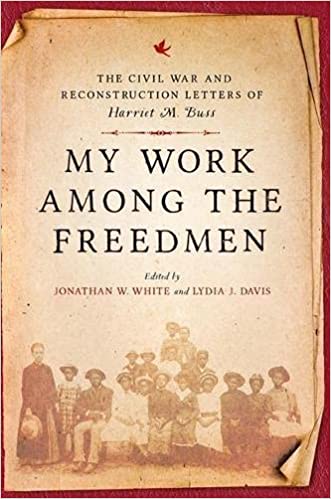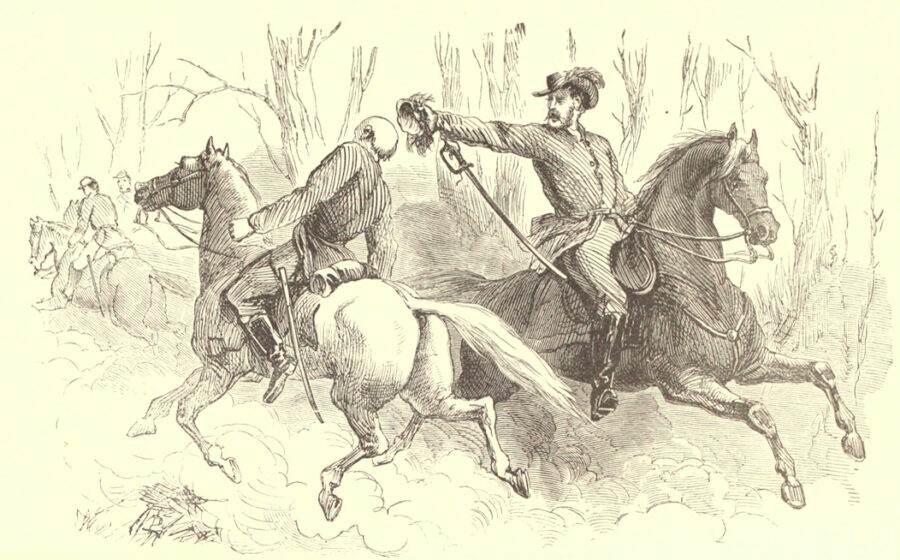My Work among the Freedmen: The Civil War and Reconstruction Letters of Harriet M. Buss edited by Jonathan W. White and Lydia J. Davis. University of Virginia Press, 2021. Cloth, ISBN: 978-0813946634. $39.50.
 History seems all too seldom interested in basically “good” people, and historians often emphasize ambiguity, complexity, or irony in describing historical actors or crafting biographies. The editors of My Work Among the Freedmen point out—and readers will appreciate—the unusual geographical and chronological range of this collection of letters written by a woman who dedicated her life to educating former slaves and their children. Yet of equal value, readers will meet Harriet M. Buss—in some respects ordinary, but in several ways extraordinary as both a person and a teacher.
History seems all too seldom interested in basically “good” people, and historians often emphasize ambiguity, complexity, or irony in describing historical actors or crafting biographies. The editors of My Work Among the Freedmen point out—and readers will appreciate—the unusual geographical and chronological range of this collection of letters written by a woman who dedicated her life to educating former slaves and their children. Yet of equal value, readers will meet Harriet M. Buss—in some respects ordinary, but in several ways extraordinary as both a person and a teacher.
Harriet Buss grew up on a farm in Sterling, Massachusetts. Early on she decided to be a teacher, but one with a very strong drive to make a difference for her students and to live a good life. In 1860, as the possibility of civil war loomed, she wrote, “I like to make something of a stir in the world once in a while, and I intend to do it as often as it seems convenient” (xxi).
Buss had Republican and abolitionist sympathies, though the letters to her parents contain only infrequent political comments. Her Baptist and evangelical convictions were a driving force in her life, but it was not until 1863 that she found her true calling as a teacher for the freedpeople. She had decided not to marry because she did not want to be controlled by a man, and indeed the desire to exercise authority was an important part of her educational career. Yet her ambition and need to manage her classroom (and her schools) proved to be a largely positive force. In her first teaching assignment at Beaufort, South Carolina, she sometimes treated her formerly enslaved students with condescension; she even referred to them as “darkeys” on a couple of occasions. At the same time, however, she grew quite impressed with African American soldiers, particularly the Union hero Robert Smalls, who offered some sharp comments on Confederate women.
Buss soon became an enthusiastic supporter of her students, putting in long hours in the classroom while also active in Sunday School work. In 1868, she arrived in Norfolk, Virginia, for a second teaching assignment. At this point, the enthusiasm for her pupils and her work became unalloyed. She found real joy in the classroom; her stamina was impressive. She sometimes taught for nine hours in a single day. Even her students worried about their teacher working too hard, but they stayed after school to talk with her and walk her back to her lodgings in the evening. Buss was a strong and determined person yet appeared to get along with everyone. Her letters contain almost entirely positive descriptions of her colleagues and students; she seemed always able to discover the best in people. She was proud of her students and herself, but her pride grew not out of vanity, but out of a fundamental decency. Buss’s most obvious character flaw was her intense anti-Catholic prejudice, and she noted that one of her goals was to protect her students from what she termed “the mockery and mummery of the Romish church” (87).
In 1869, Buss began her third and final teaching assignment in North Carolina at the Raleigh Baptist Institute for the Education of Colored Men for the Ministry, which later became Shaw University. She returned to Massachusetts when her parents’ health declined, but in 1887 came back to Raleigh and continued to work at Shaw until her death in 1895.
Buss’s letters contain a wealth of information on domestic arrangements, in part revealed in the lists of items requested from northern family and friends. Buss enjoyed eating and mentioned food often; Thanksgiving was clearly her favorite holiday. Students of the Reconstruction period will benefit primarily from the light these letters shed on race relations and education, but there are a few fleeting references to the impeachment of Andrew Johnson, Ulysses S. Grant, and other issues of the day. Buss was at times critical of southern whites, and at one point admitted that she would like to have seen Jefferson and other leading Confederates hanged. Yet she seldom faced any ill treatment in the South, and her letters exude a hopeful outlook on the present and future.
Jonathan White and Lydia Davis have a done a fine job introducing readers to Harriet Buss and her world. The editorial work is excellent, both in the introductions to each section of letters and in the annotations. Unlike many edited collections, this one has a thorough subject index that will assist a wide range of researchers. At the same time, My Work Among the Freedmen is simply worth reading to meet Harriet Buss and her students.
George C. Rable, the author of many books on the Civil War and its era, is Professor of History Emeritus at the University of Alabama.
